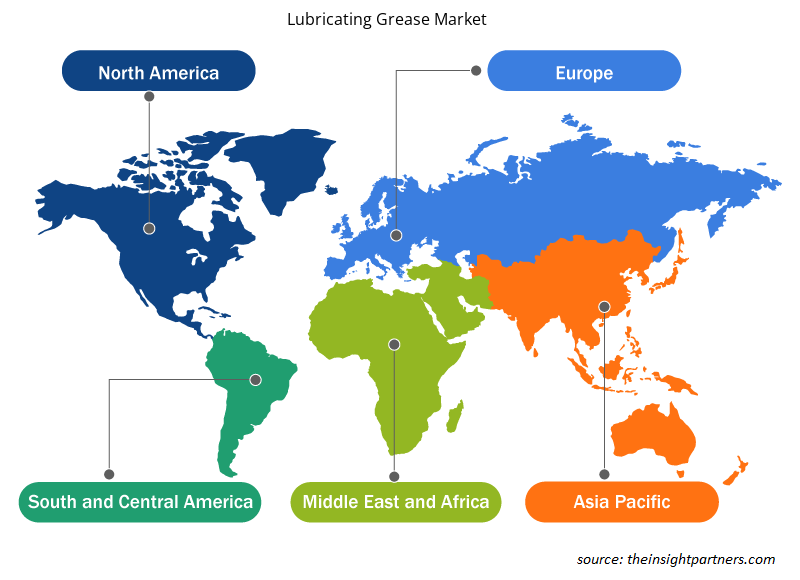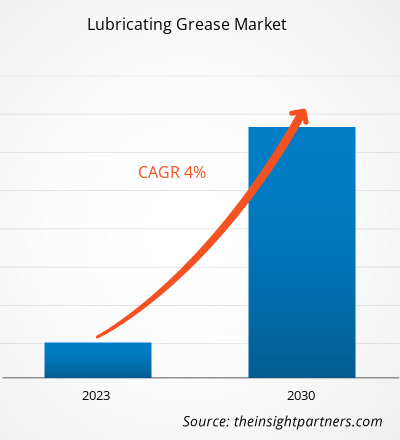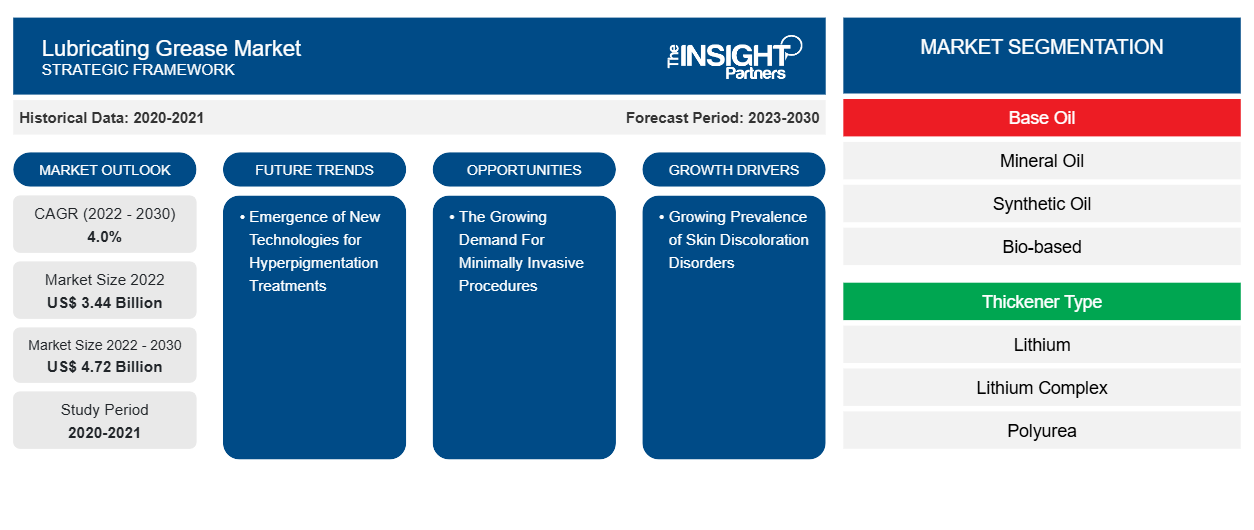[Informe de investigación] El tamaño del mercado de grasas lubricantes se valoró en US$ 3.44 mil millones en 2022 y se espera que alcance los US$ 4.72 mil millones para 2030; se estima que registrará una CAGR del 4,0% de 2022 a 2030.
Perspectivas del mercado y opinión de analistas:
La grasa lubricante es un lubricante semifluido o sólido compuesto por un aceite base, un espesante y aditivos. El aceite base proporciona lubricación, el espesante le da a la grasa su consistencia y los aditivos mejoran su rendimiento. La grasa reduce la fricción, protege contra el desgaste y proporciona sellado en diversas aplicaciones, como la automoción, la maquinaria industrial y los cojinetes. Su capacidad para adherirse a las superficies la hace eficaz en situaciones en las que el aceite por sí solo podría no permanecer en su lugar. La elección de la grasa adecuada depende de factores como la temperatura, la carga y las condiciones de funcionamiento. Este lubricante encuentra una amplia aplicación en todas las industrias, incluidas la automoción, la fabricación y la maquinaria. Su naturaleza semisólida le permite adherirse a las superficies, lo que la hace eficaz cuando los lubricantes líquidos no son prácticos. La grasa es especialmente preferida en aplicaciones que involucran cojinetes, engranajes y otros componentes expuestos a condiciones difíciles. La selección adecuada de la grasa depende de factores como la temperatura de funcionamiento, la carga y los requisitos específicos del equipo o la maquinaria involucrados. Todos estos factores favorecen positivamente el mercado de grasas lubricantes.
Factores impulsores del crecimiento y desafíos:
La grasa lubricante es uno de los componentes clave utilizados en el sector industrial, que ayuda a que el equipo funcione de manera eficiente y ofrezca la máxima confiabilidad. Se utiliza en varias industrias, como la automotriz, el petróleo y el gas, los textiles, el vidrio, la generación de energía , el papel y la pulpa, los productos químicos, los petroquímicos, la agricultura, la marina, la fabricación industrial, los alimentos y las bebidas y los productos farmacéuticos. A medida que las economías en desarrollo experimentan una transformación significativa, con el auge de los sectores manufacturero, de la construcción y de la industria, la dependencia de las soluciones de lubricación se vuelve primordial. A raíz de esta rápida industrialización, la grasa lubricante está experimentando una mayor demanda para garantizar el rendimiento óptimo y la longevidad de los equipos industriales. Las grasas lubricantes atienden el funcionamiento perfecto de la maquinaria de fabricación y sostienen el impulso de la producción industrial. Paralelamente, la industria de la construcción, piedra angular de la industrialización, influye significativamente en la demanda de grasa lubricante. India es uno de los mercados de construcción más importantes a nivel mundial. El crecimiento de las actividades de construcción en India está impulsado por la industrialización continua, el crecimiento de la población, el aumento de los ingresos de la clase media y el desarrollo de la infraestructura. Por lo tanto, todos estos factores están impulsando el crecimiento del mercado de grasas lubricantes.
Sin embargo, las regulaciones y normas gubernamentales desempeñan un papel fundamental en la configuración del panorama del mercado de grasas lubricantes. Según el International Journal of Innovative Science, Engineering & Technology, se estima que, en la actualidad, aproximadamente el 50% de todos los lubricantes vendidos en todo el mundo terminan en el medio ambiente a través de aplicaciones de pérdida total, volatilidad, derrames o accidentes. El enfoque creciente en la sostenibilidad ambiental y la seguridad ha llevado a la implementación de políticas estrictas que apuntan a regular la composición, los procesos de producción y el uso de grasas lubricantes. Esto ha planteado implicaciones significativas para los fabricantes, ya que deben navegar en un entorno regulatorio complejo para garantizar el cumplimiento. Los gobiernos de todo el mundo están imponiendo estándares más estrictos sobre la composición de las grasas lubricantes para reducir el impacto ambiental. Los requisitos de biodegradabilidad, toxicidad reducida y limitaciones en ciertos aditivos contribuyen a la necesidad de reformulación y adopción continuas por parte de los fabricantes. Estos factores podrían limitar el crecimiento del mercado de grasas lubricantes.
Personalice este informe según sus necesidades
Obtendrá personalización en cualquier informe, sin cargo, incluidas partes de este informe o análisis a nivel de país, paquete de datos de Excel, así como también grandes ofertas y descuentos para empresas emergentes y universidades.
-
Obtenga las principales tendencias clave del mercado de este informe.Esta muestra GRATUITA incluirá análisis de datos, desde tendencias del mercado hasta estimaciones y pronósticos.
Segmentación y alcance del informe:
El "Análisis del mercado mundial de grasas lubricantes hasta 2030" es un estudio especializado y profundo que se centra principalmente en las tendencias del mercado y las oportunidades de crecimiento en todo el mundo. El informe tiene como objetivo proporcionar una descripción general del mercado con una segmentación detallada del mercado en términos de aceite base, tipo de espesante e industria de uso final. El mercado ha experimentado un alto crecimiento en el pasado reciente y se espera que continúe con esta tendencia durante el período de pronóstico. El informe proporciona estadísticas clave sobre el consumo de grasas lubricantes a nivel mundial. Además, el informe del mercado mundial de grasas lubricantes proporciona una evaluación cualitativa de varios factores que afectan el desempeño del mercado a nivel mundial. El informe también incluye un análisis integral de los principales actores del mercado y sus desarrollos estratégicos clave. También se incluyen varios análisis sobre la dinámica del mercado para ayudar a identificar los factores impulsores clave, las tendencias del mercado y las oportunidades lucrativas que, a su vez, ayudarían a identificar los principales bolsillos de ingresos.
El pronóstico del mercado de grasas lubricantes se estima sobre la base de varios hallazgos de investigación primaria y secundaria, como publicaciones de empresas clave, datos de asociaciones y bases de datos. Además, el análisis del ecosistema y el análisis de las cinco fuerzas de Porter brindan una visión de 360 grados del mercado, que ayuda a comprender toda la cadena de suministro y varios factores que afectan el desempeño del mercado.
Análisis segmental:
Por aceite base, el mercado se segmenta en aceite mineral, aceite sintético (polialquilenglicol, polialfaolefina y ésteres) y de base biológica. En términos de tipo de espesante, el mercado se segmenta en litio, complejo de litio, poliurea, sulfonato de calcio, calcio anhidro, complejo de aluminio y otros. En términos de industria de uso final, el mercado se divide en vehículos convencionales, vehículos eléctricos , construcción y edificación, minería, marina, alimentos, energía y electricidad, y otros. El segmento de vehículos convencionales registró una importante participación de mercado de grasas lubricantes en 2022. La grasa automotriz se utiliza en vehículos convencionales para mejorar el rendimiento del motor. Las florecientes industrias automotrices en las economías en desarrollo y la I+D en curso para productos de grasa avanzados benefician al mercado de grasas lubricantes para aplicaciones automotrices. La grasa juega un papel crucial en la industria automotriz. Ayudan a reducir la fricción, transferir calor, prevenir la corrosión y proteger contra el desgaste. Los avances en la grasa han dado como resultado composiciones que admiten intervalos de servicio más largos, mayor longevidad de la máquina, mayor eficiencia de combustible y niveles reducidos de contaminantes. La grasa que se utiliza en los vehículos convencionales para la lubricación de cojinetes, juntas o engranajes está compuesta principalmente por aceite sintético o mineral. Todos estos factores están impulsando el mercado de grasas lubricantes para el segmento de vehículos convencionales.
Análisis regional:
El alcance del mercado se centra en cinco regiones clave: América del Norte, Europa, Asia Pacífico, Oriente Medio y África, y América del Sur y Central. En términos de ingresos, Asia Pacífico dominó la participación de mercado de grasas lubricantes, que representó ~US$ 2 mil millones en 2022. A medida que las industrias de uso final, como la automotriz, la fabricación, la construcción y la energía, continúan creciendo y adoptando tecnologías avanzadas, existe una mayor necesidad de soluciones de lubricación eficientes y confiables para garantizar un rendimiento óptimo y la longevidad de la maquinaria y el equipo. El sector automotriz en la región de Asia Pacífico juega un papel fundamental en el impulso de las tendencias del mercado de grasas lubricantes, con una creciente demanda de grasas especiales diseñadas para satisfacer los requisitos únicos de los vehículos modernos. Esto incluye grasas formuladas para vehículos eléctricos, que están ganando popularidad en medio del impulso global hacia el transporte sostenible. Además, las grasas se utilizan en aplicaciones aeroespaciales para la lubricación de cojinetes de aeronaves , accesorios de motor, correderas y juntas para protegerlos de la corrosión y las condiciones extremas. Los gobiernos de los países de Asia Pacífico han invertido significativamente en tecnología y programas de investigación en el sector aeroespacial. Todos estos factores están impulsando el mercado en Asia Pacífico.
Se espera que Europa registre una CAGR de más del 4% entre 2022 y 2030. El mercado de grasas lubricantes en Europa está impulsado principalmente por una combinación de avances tecnológicos, estándares regulatorios estrictos y la sólida infraestructura industrial de la región. Además, el sector de la construcción de Europa se ha expandido constantemente, impulsado por una población en aumento. Además, es probable que los rápidos cambios en las tendencias comerciales de remodelación, como la remodelación para la accesibilidad, la combinación de estilos, las personalizaciones y las integraciones tecnológicas, respalden la expansión comercial. Además, se estima que el mercado en América del Norte alcanzará ~US$ 900 millones para 2030. La región ofrece amplias oportunidades de crecimiento para los fabricantes de grasas lubricantes debido a la creciente demanda de grasas de las industrias de uso final como la construcción, la automoción, la aeroespacial y la minería. La industria de la construcción está floreciendo en América del Norte debido a las inversiones gubernamentales en proyectos de construcción residencial y al aumento de las actividades de renovación. La grasa lubricante también mejora el rendimiento de las máquinas y los componentes utilizados en la industria de la construcción. Se espera que el aumento de la cantidad de instalaciones de turbinas eólicas debido a la mayor demanda de energía renovable genere oportunidades lucrativas para los actores del mercado de grasas lubricantes. Según la Oficina de Eficiencia Energética y Energía Renovable, la industria eólica estadounidense instaló 13.413 megavatios (MW) de nueva capacidad eólica en 2021. Las grasas se utilizan para proteger componentes críticos como el eje principal, la orientación, el paso y el cojinete del generador de las condiciones climáticas extremas y otros contaminantes en la industria de la energía eólica.
Perspectivas regionales del mercado de grasas lubricantes
Los analistas de Insight Partners explicaron en detalle las tendencias y los factores regionales que influyen en el mercado de grasas lubricantes durante el período de pronóstico. Esta sección también analiza los segmentos y la geografía del mercado de grasas lubricantes en América del Norte, Europa, Asia Pacífico, Oriente Medio y África, y América del Sur y Central.

- Obtenga datos regionales específicos para el mercado de grasas lubricantes
Alcance del informe de mercado de grasas lubricantes
| Atributo del informe | Detalles |
|---|---|
| Tamaño del mercado en 2022 | US$ 3,44 mil millones |
| Tamaño del mercado en 2030 | 4.720 millones de dólares estadounidenses |
| CAGR global (2022-2030) | 4.0% |
| Datos históricos | 2020-2021 |
| Período de pronóstico | 2023-2030 |
| Segmentos cubiertos |
Por aceite base
|
| Regiones y países cubiertos |
América del norte
|
| Líderes del mercado y perfiles de empresas clave |
|
Densidad de actores del mercado de grasas lubricantes: comprensión de su impacto en la dinámica empresarial
El mercado de grasas lubricantes está creciendo rápidamente, impulsado por la creciente demanda de los usuarios finales debido a factores como la evolución de las preferencias de los consumidores, los avances tecnológicos y una mayor conciencia de los beneficios del producto. A medida que aumenta la demanda, las empresas amplían sus ofertas, innovan para satisfacer las necesidades de los consumidores y aprovechan las tendencias emergentes, lo que impulsa aún más el crecimiento del mercado.
La densidad de actores del mercado se refiere a la distribución de las empresas o firmas que operan dentro de un mercado o industria en particular. Indica cuántos competidores (actores del mercado) están presentes en un espacio de mercado determinado en relación con su tamaño o valor total de mercado.
Las principales empresas que operan en el mercado de grasas lubricantes son:
- Corporación Exxon Mobil
- Fuchs SE
- Petroleum Nasional Bhd
- Shell Sociedad Anónima
- Kluber Lubrication GmbH & Co. KG (empresa de lubricación)
Descargo de responsabilidad : Las empresas enumeradas anteriormente no están clasificadas en ningún orden particular.

- Obtenga una descripción general de los principales actores clave del mercado de grasas lubricantes
Desarrollos industriales y oportunidades futuras:
A continuación se enumeran algunas iniciativas adoptadas por los actores clave que operan en el mercado de grasas lubricantes:
- En marzo de 2023, ExxonMobil anunció la inversión de casi 110 millones de dólares estadounidenses (900 millones de rupias indias) para construir una planta de fabricación de lubricantes en el Área Industrial Isambe de la Corporación de Desarrollo Industrial de Maharashtra en Raigad.
- En marzo de 2021, el Grupo FUCHS invirtió 26 millones de dólares estadounidenses (25 millones de euros) en su planta de Kaiserslautern e inauguró oficialmente una planta de producción.
- En diciembre de 2022, Pennzoil-Quaker State Company d/b/a SOPUS Products, una subsidiaria de propiedad absoluta de Shell USA, Inc. que comprende el negocio de lubricantes de Shell en EE. UU., adquirió TFH Reliability Group, LLC, la empresa matriz de Allied Reliability Inc.
Panorama competitivo y empresas clave:
Entre los actores clave que aparecen en el informe del mercado de grasas lubricantes se encuentran Exxon Mobil Corp, Fuchs SE, Petroliam Nasional Bhd, Shell Plc, Kluber Lubrication GmbH & Co KG, TotalEnergies SE, BP Plc, Chevron Corp, Valvoline Inc y Axel Christiernsson AB. Los actores del mercado global se centran en proporcionar productos de alta calidad para satisfacer la demanda de los clientes.
- Análisis histórico (2 años), año base, pronóstico (7 años) con CAGR
- Análisis PEST y FODA
- Tamaño del mercado, valor/volumen: global, regional y nacional
- Industria y panorama competitivo
- Conjunto de datos de Excel
Informes recientes
Informes relacionados
Testimonios
Razón para comprar
- Toma de decisiones informada
- Comprensión de la dinámica del mercado
- Análisis competitivo
- Información sobre clientes
- Pronósticos del mercado
- Mitigación de riesgos
- Planificación estratégica
- Justificación de la inversión
- Identificación de mercados emergentes
- Mejora de las estrategias de marketing
- Impulso de la eficiencia operativa
- Alineación con las tendencias regulatorias























 Obtenga una muestra gratuita para - Mercado de grasas lubricantes
Obtenga una muestra gratuita para - Mercado de grasas lubricantes